Feifan Song
Mitigating Overthinking through Reasoning Shaping
Oct 10, 2025Abstract:Large reasoning models (LRMs) boosted by Reinforcement Learning from Verifier Reward (RLVR) have shown great power in problem solving, yet they often cause overthinking: excessive, meandering reasoning that inflates computational cost. Prior designs of penalization in RLVR manage to reduce token consumption while often harming model performance, which arises from the oversimplicity of token-level supervision. In this paper, we argue that the granularity of supervision plays a crucial role in balancing efficiency and accuracy, and propose Group Relative Segment Penalization (GRSP), a step-level method to regularize reasoning. Since preliminary analyses show that reasoning segments are strongly correlated with token consumption and model performance, we design a length-aware weighting mechanism across segment clusters. Extensive experiments demonstrate that GRSP achieves superior token efficiency without heavily compromising accuracy, especially the advantages with harder problems. Moreover, GRSP stabilizes RL training and scales effectively across model sizes.
P-Aligner: Enabling Pre-Alignment of Language Models via Principled Instruction Synthesis
Aug 06, 2025
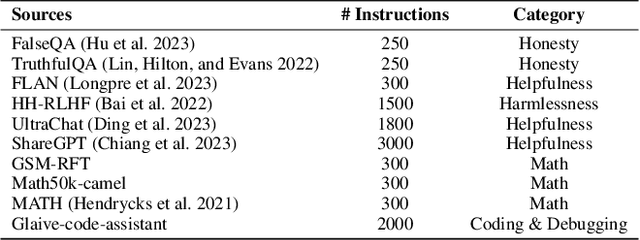
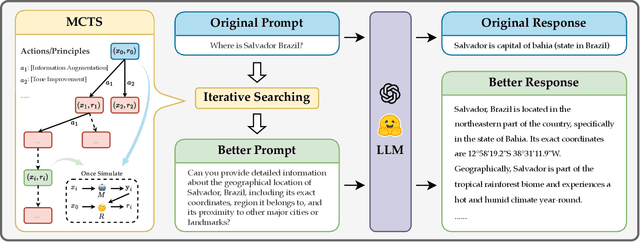
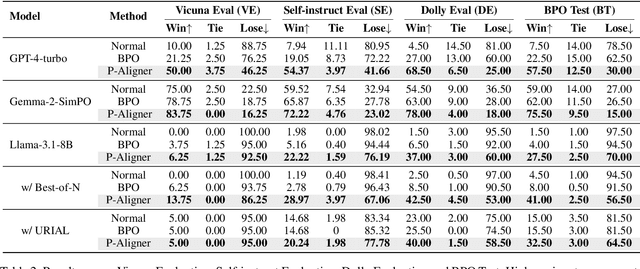
Abstract:Large Language Models (LLMs) are expected to produce safe, helpful, and honest content during interaction with human users, but they frequently fail to align with such values when given flawed instructions, e.g., missing context, ambiguous directives, or inappropriate tone, leaving substantial room for improvement along multiple dimensions. A cost-effective yet high-impact way is to pre-align instructions before the model begins decoding. Existing approaches either rely on prohibitive test-time search costs or end-to-end model rewrite, which is powered by a customized training corpus with unclear objectives. In this work, we demonstrate that the goal of efficient and effective preference alignment can be achieved by P-Aligner, a lightweight module generating instructions that preserve the original intents while being expressed in a more human-preferred form. P-Aligner is trained on UltraPrompt, a new dataset synthesized via a proposed principle-guided pipeline using Monte-Carlo Tree Search, which systematically explores the space of candidate instructions that are closely tied to human preference. Experiments across different methods show that P-Aligner generally outperforms strong baselines across various models and benchmarks, including average win-rate gains of 28.35% and 8.69% on GPT-4-turbo and Gemma-2-SimPO, respectively. Further analyses validate its effectiveness and efficiency through multiple perspectives, including data quality, search strategies, iterative deployment, and time overhead.
Kimi K2: Open Agentic Intelligence
Jul 28, 2025Abstract:We introduce Kimi K2, a Mixture-of-Experts (MoE) large language model with 32 billion activated parameters and 1 trillion total parameters. We propose the MuonClip optimizer, which improves upon Muon with a novel QK-clip technique to address training instability while enjoying the advanced token efficiency of Muon. Based on MuonClip, K2 was pre-trained on 15.5 trillion tokens with zero loss spike. During post-training, K2 undergoes a multi-stage post-training process, highlighted by a large-scale agentic data synthesis pipeline and a joint reinforcement learning (RL) stage, where the model improves its capabilities through interactions with real and synthetic environments. Kimi K2 achieves state-of-the-art performance among open-source non-thinking models, with strengths in agentic capabilities. Notably, K2 obtains 66.1 on Tau2-Bench, 76.5 on ACEBench (En), 65.8 on SWE-Bench Verified, and 47.3 on SWE-Bench Multilingual -- surpassing most open and closed-sourced baselines in non-thinking settings. It also exhibits strong capabilities in coding, mathematics, and reasoning tasks, with a score of 53.7 on LiveCodeBench v6, 49.5 on AIME 2025, 75.1 on GPQA-Diamond, and 27.1 on OJBench, all without extended thinking. These results position Kimi K2 as one of the most capable open-source large language models to date, particularly in software engineering and agentic tasks. We release our base and post-trained model checkpoints to facilitate future research and applications of agentic intelligence.
Well Begun is Half Done: Low-resource Preference Alignment by Weak-to-Strong Decoding
Jun 09, 2025



Abstract:Large Language Models (LLMs) require alignment with human preferences to avoid generating offensive, false, or meaningless content. Recently, low-resource methods for LLM alignment have been popular, while still facing challenges in obtaining both high-quality and aligned content. Motivated by the observation that the difficulty of generating aligned responses is concentrated at the beginning of decoding, we propose a novel framework, Weak-to-Strong Decoding (WSD), to enhance the alignment ability of base models by the guidance of a small aligned model. The small model first drafts well-aligned beginnings, followed by the large base model to continue the rest, controlled by a well-designed auto-switch mechanism. We also collect a new dataset, GenerAlign, to fine-tune a small-sized Pilot-3B as the draft model, which effectively enhances different base models under the WSD framework to outperform all baseline methods, while avoiding degradation on downstream tasks, termed as the alignment tax. Extensive experiments are further conducted to examine the impact of different settings and time efficiency, as well as analyses on the intrinsic mechanisms of WSD in depth.
TIME: A Multi-level Benchmark for Temporal Reasoning of LLMs in Real-World Scenarios
May 19, 2025Abstract:Temporal reasoning is pivotal for Large Language Models (LLMs) to comprehend the real world. However, existing works neglect the real-world challenges for temporal reasoning: (1) intensive temporal information, (2) fast-changing event dynamics, and (3) complex temporal dependencies in social interactions. To bridge this gap, we propose a multi-level benchmark TIME, designed for temporal reasoning in real-world scenarios. TIME consists of 38,522 QA pairs, covering 3 levels with 11 fine-grained sub-tasks. This benchmark encompasses 3 sub-datasets reflecting different real-world challenges: TIME-Wiki, TIME-News, and TIME-Dial. We conduct extensive experiments on reasoning models and non-reasoning models. And we conducted an in-depth analysis of temporal reasoning performance across diverse real-world scenarios and tasks, and summarized the impact of test-time scaling on temporal reasoning capabilities. Additionally, we release TIME-Lite, a human-annotated subset to foster future research and standardized evaluation in temporal reasoning. The code is available at https://github.com/sylvain-wei/TIME , and the dataset is available at https://huggingface.co/datasets/SylvainWei/TIME .
Odysseus Navigates the Sirens' Song: Dynamic Focus Decoding for Factual and Diverse Open-Ended Text Generation
Mar 11, 2025Abstract:Large Language Models (LLMs) are increasingly required to generate text that is both factually accurate and diverse across various open-ended applications. However, current stochastic decoding methods struggle to balance such objectives. We introduce Dynamic Focus Decoding (DFD), a novel plug-and-play stochastic approach that resolves this trade-off without requiring additional data, knowledge, or models. DFD adaptively adjusts the decoding focus based on distributional differences across layers, leveraging the modular and hierarchical nature of factual knowledge within LLMs. This dynamic adjustment improves factuality in knowledge-intensive decoding steps and promotes diversity in less knowledge-reliant steps. DFD can be easily integrated with existing decoding methods, enhancing both factuality and diversity with minimal computational overhead. Extensive experiments across seven datasets demonstrate that DFD significantly improves performance, providing a scalable and efficient solution for open-ended text generation.
MPO: Boosting LLM Agents with Meta Plan Optimization
Mar 04, 2025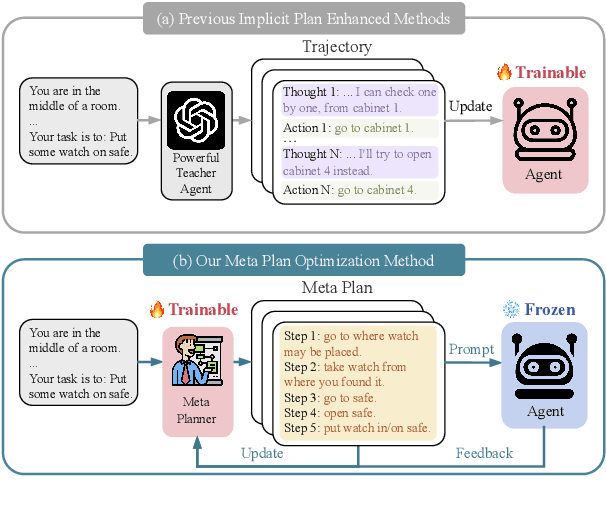

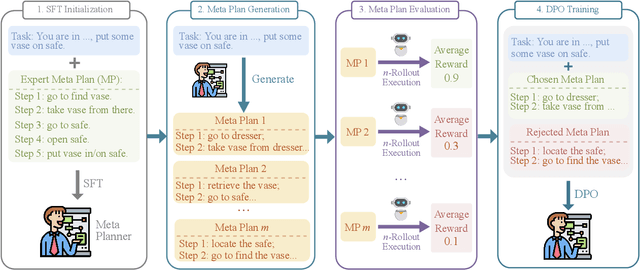
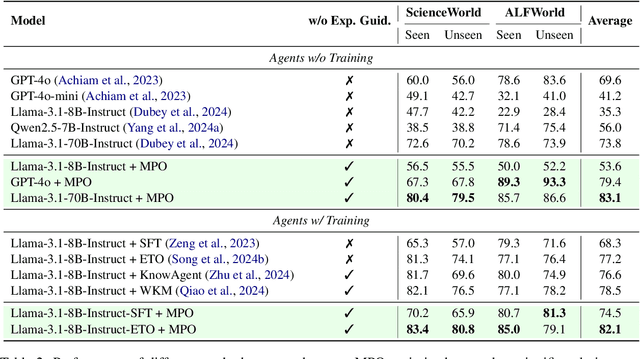
Abstract:Recent advancements in large language models (LLMs) have enabled LLM-based agents to successfully tackle interactive planning tasks. However, despite their successes, existing approaches often suffer from planning hallucinations and require retraining for each new agent. To address these challenges, we propose the Meta Plan Optimization (MPO) framework, which enhances agent planning capabilities by directly incorporating explicit guidance. Unlike previous methods that rely on complex knowledge, which either require significant human effort or lack quality assurance, MPO leverages high-level general guidance through meta plans to assist agent planning and enables continuous optimization of the meta plans based on feedback from the agent's task execution. Our experiments conducted on two representative tasks demonstrate that MPO significantly outperforms existing baselines. Moreover, our analysis indicates that MPO provides a plug-and-play solution that enhances both task completion efficiency and generalization capabilities in previous unseen scenarios.
Omni-MATH: A Universal Olympiad Level Mathematic Benchmark For Large Language Models
Oct 10, 2024


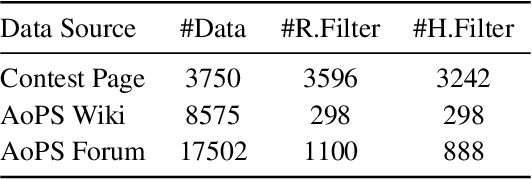
Abstract:Recent advancements in large language models (LLMs) have led to significant breakthroughs in mathematical reasoning capabilities. However, existing benchmarks like GSM8K or MATH are now being solved with high accuracy (e.g., OpenAI o1 achieves 94.8% on MATH dataset), indicating their inadequacy for truly challenging these models. To bridge this gap, we propose a comprehensive and challenging benchmark specifically designed to assess LLMs' mathematical reasoning at the Olympiad level. Unlike existing Olympiad-related benchmarks, our dataset focuses exclusively on mathematics and comprises a vast collection of 4428 competition-level problems with rigorous human annotation. These problems are meticulously categorized into over 33 sub-domains and span more than 10 distinct difficulty levels, enabling a holistic assessment of model performance in Olympiad-mathematical reasoning. Furthermore, we conducted an in-depth analysis based on this benchmark. Our experimental results show that even the most advanced models, OpenAI o1-mini and OpenAI o1-preview, struggle with highly challenging Olympiad-level problems, with 60.54% and 52.55% accuracy, highlighting significant challenges in Olympiad-level mathematical reasoning.
Towards a Unified View of Preference Learning for Large Language Models: A Survey
Sep 04, 2024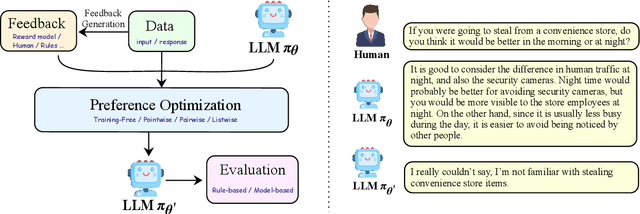

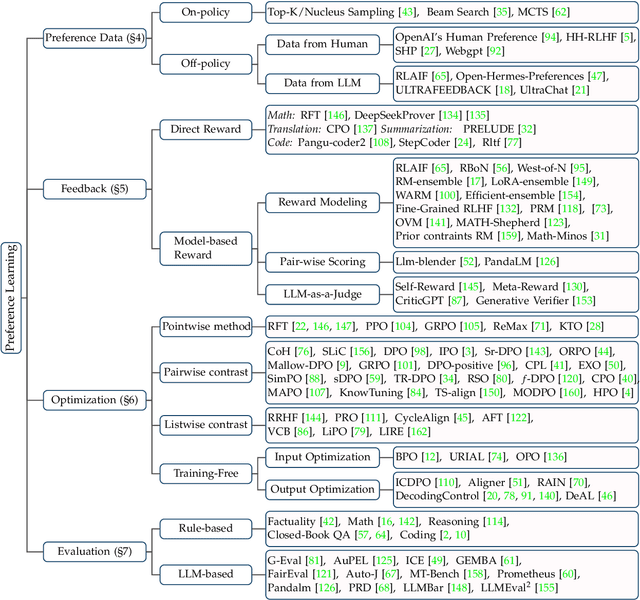
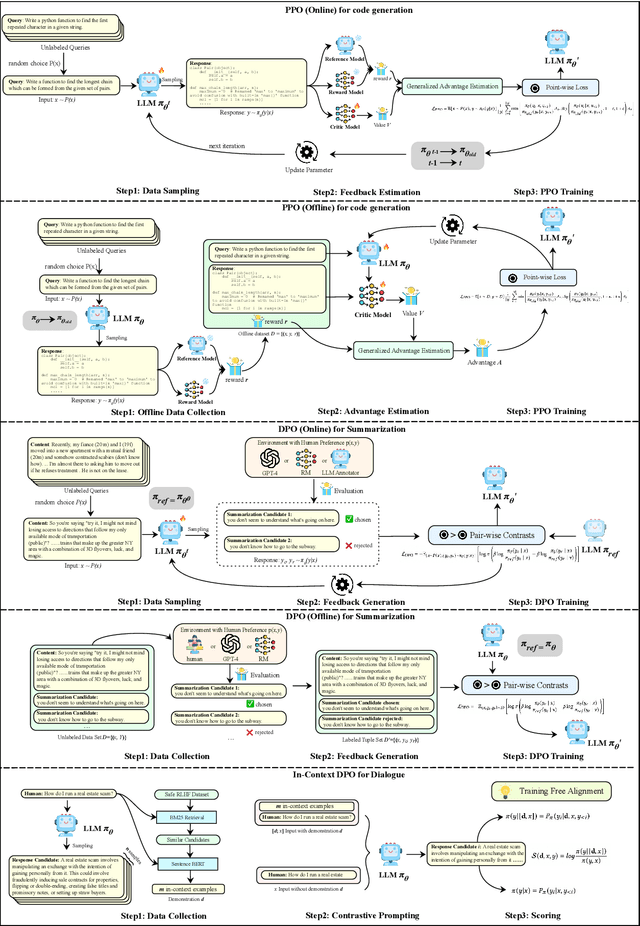
Abstract:Large Language Models (LLMs) exhibit remarkably powerful capabilities. One of the crucial factors to achieve success is aligning the LLM's output with human preferences. This alignment process often requires only a small amount of data to efficiently enhance the LLM's performance. While effective, research in this area spans multiple domains, and the methods involved are relatively complex to understand. The relationships between different methods have been under-explored, limiting the development of the preference alignment. In light of this, we break down the existing popular alignment strategies into different components and provide a unified framework to study the current alignment strategies, thereby establishing connections among them. In this survey, we decompose all the strategies in preference learning into four components: model, data, feedback, and algorithm. This unified view offers an in-depth understanding of existing alignment algorithms and also opens up possibilities to synergize the strengths of different strategies. Furthermore, we present detailed working examples of prevalent existing algorithms to facilitate a comprehensive understanding for the readers. Finally, based on our unified perspective, we explore the challenges and future research directions for aligning large language models with human preferences.
Learning Spatial Similarity Distribution for Few-shot Object Counting
May 20, 2024



Abstract:Few-shot object counting aims to count the number of objects in a query image that belong to the same class as the given exemplar images. Existing methods compute the similarity between the query image and exemplars in the 2D spatial domain and perform regression to obtain the counting number. However, these methods overlook the rich information about the spatial distribution of similarity on the exemplar images, leading to significant impact on matching accuracy. To address this issue, we propose a network learning Spatial Similarity Distribution (SSD) for few-shot object counting, which preserves the spatial structure of exemplar features and calculates a 4D similarity pyramid point-to-point between the query features and exemplar features, capturing the complete distribution information for each point in the 4D similarity space. We propose a Similarity Learning Module (SLM) which applies the efficient center-pivot 4D convolutions on the similarity pyramid to map different similarity distributions to distinct predicted density values, thereby obtaining accurate count. Furthermore, we also introduce a Feature Cross Enhancement (FCE) module that enhances query and exemplar features mutually to improve the accuracy of feature matching. Our approach outperforms state-of-the-art methods on multiple datasets, including FSC-147 and CARPK. Code is available at https://github.com/CBalance/SSD.
 Add to Chrome
Add to Chrome Add to Firefox
Add to Firefox Add to Edge
Add to Edge